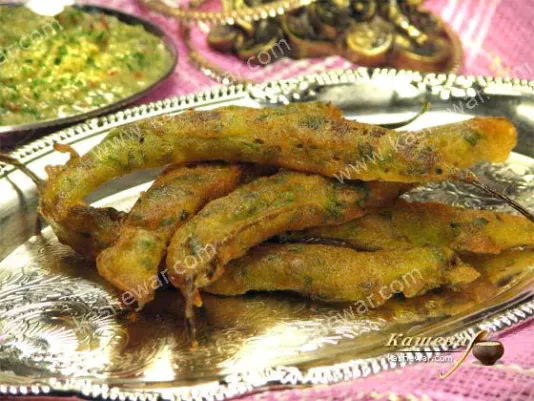Eggplant Raita
Eggplant raita is a recipe for Indian cuisine, this recipe, like all Indian cuisine, is very aromatic and can be spicy if you’re not used to it.

Indian cuisine is one of the oldest and most diverse in the world. It has developed over thousands of years under the influence of religions, climate, cultural exchange, and Ayurvedic philosophy. The diet is based on grains (rice, wheat), legumes (lentils, chickpeas), vegetables, spices, dairy products, and oils. Dishes can be entirely vegetarian or include meat such as chicken, lamb, or fish. Beef is prohibited by most Indian traditions, and pork is rarely used. Great importance is given to the balance of tastes – sweet, sour, salty, bitter, spicy, and astringent – which is achieved through the use of dozens of spices. Turmeric, cumin, coriander, cloves, mustard seeds, asafoetida, ginger, cardamom, and fenugreek form the base of Indian flavor. Food is not just a way to satisfy hunger, but a part of spiritual practice and care for both body and soul. Regional diversity means there is not one Indian cuisine, but dozens of variations, each worthy of attention.
Indian recipes are based on the combination of local ingredients, spices, and techniques that create a unique flavor. Dal – a dish made from legumes – exists in hundreds of variations depending on the region. Curry is a universal term encompassing stews of vegetables, meat, or fish in thick sauces with masalas. Lamb in tomato sauce, tandoori chicken, spiced pilaf, and potato samosas are just a few examples of the depth of Indian recipes. Cooking often involves frying spices in ghee or oil, simmering until tender, and gradually adding ingredients to create a complex aromatic composition. There are many types of flatbreads: chapati, roti, naan, paratha – served with every dish. Street snacks like chaat, pakora, and bhaji are also popular. Everything is prepared with fresh ingredients and deep respect for tradition. Recipes are passed down in families and tied to castes, regions, and religious rituals. Indian cuisine is a living tradition where every recipe has a soul.
India is an incredibly large and diverse country, and this is clearly reflected in its gastronomy. Northern India is known for wheat-based dishes, creamy sauces, meat curries, and the use of ghee, yogurt, dried apricots, and almonds. This region includes Punjab, Delhi, and Kashmir – famous for hearty, aromatic dishes like paneer tikka, chicken masala, and aloo gobi. Southern India is the land of rice, coconuts, and legumes. It is known for dosas, sambar, rasam, and spicy dishes with mustard seeds and asafoetida. Western India (Gujarat, Maharashtra, Goa) features a bold mix of sweet, sour, and spicy flavors, often using coconut, seafood, and vinegar. Eastern India (Bengal, Assam) is famous for its fish, mustard, rice, and sweets. Each region has its own culinary language, style of serving, and traditions related to fasting and festivals. This diversity allows Indian cuisine to be both local and universal, preserving unity through variety.
Spices are the heart of Indian cuisine. They not only enhance flavor but also have healing properties and help balance the body’s energies and emotions. Every dish is crafted as a harmonious spice blend known as masala. There are hundreds of masalas: garam masala, chaat masala, sambar masala, chana masala – each with its unique composition. Both whole spices (mustard seeds, cardamom, cloves) and ground ones (turmeric, cumin, coriander) are used. The technique of frying spices in hot ghee or oil (known as "tempering") releases aromas and forms the flavor base. Turmeric is used in nearly every dish due to its antibacterial properties. Ginger and garlic are essential components of many sauces. Dried mango, asafoetida, and fenugreek are also often added. Indians learn to cook with spices from childhood, understanding their effects on the body. This knowledge gives Indian cuisine a flavor depth that is hard to replicate without traditional techniques.
Vegetarianism is the main dietary practice in many parts of India, especially among Hindus, Jains, and Buddhists. Most dishes are meatless but highly nutritious thanks to legumes, dairy products, grains, and spices. Paneer (fresh cheese) is widely used in dishes like paneer tikka and shahi paneer. Yogurt is added to curries, used in marinades, and consumed as lassi. Ghee is considered sacred and used both in cooking and religious rituals. Strict dietary rules exist – many Hindus do not eat beef, and Muslims avoid pork. Eating habits are tied to religious calendars, fasting, and rituals. Even in regions where meat is common, there are separate vegetarian meals for specific days. This approach makes Indian cuisine flexible, morally grounded, and culturally sensitive. It ensures a rich diet without meat, with respect for life and belief.
Indian sweets (mithai) are a culinary heritage of their own. They are made from milk, ghee, flour, sugar, nuts, and spices. Popular sweets include rasgulla, gulab jamun, burfi, jalebi, laddu, and halwa – all vibrant, sweet, and fragrant, often flavored with rose water or cardamom. Drinks are also important: masala chai with milk and spices, lassi (a yogurt-based drink), coconut water, ayrish, and various herbal and spiced infusions. Indian meals are always a communal experience. Food is served on metal plates (thali) with several dishes – rice, bread, dal, vegetables, chutney, and dessert. People eat with their hands, especially the right hand, in a calm and respectful setting. Eating is a way to express love, family warmth, and care. Indian cuisine is not just a collection of flavors, but a living philosophy where food is a path to harmony with oneself and the world.